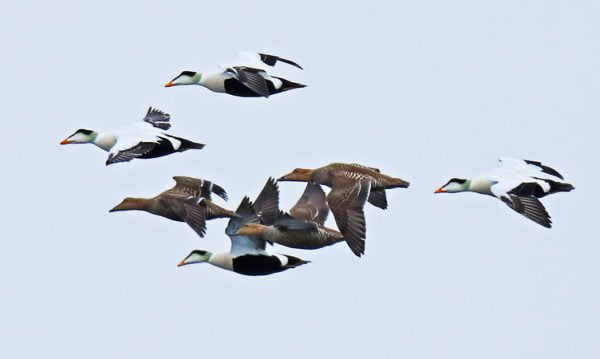Lead Institution(s): Canadian Wildlife Service
Project Lead: Grant Gilchrist
Collaborator(s): Flemming Merkel (Greenland Institute of Natural Resources) and Anders Mosbech (National Environmental Research Institute, Denmark)
Location: Nunavut, Greenland
Focal Species: Common Eider (Somateria mollissima), King Eider (Somateria spectabilis)
Project Description: Common and King Eider ducks are heavily hunted in northeastern Canada and west Greenland. In Greenland alone, more than 90,000 eiders are killed annually; a level of harvest that may not be sustainable. Recent evidence suggests that many eiders breeding in arctic Canada migrate to Greenland to winter, but details of their migration and wintering areas are unknown. A key requirement to assess the sustainability of the harvest in Greenland is to identify affinities between eider breeding populations in both Canada and Greenland and their wintering grounds. In response, an international research team (Greenland, Canada, Denmark) initiated a satellite telemetry study in 2001 to generate information on the wintering affinities of these Common and King eider populations. Transmitters were implanted in Canada and Greenland in 2001, in Greenland only in 2002, and in both Canada and Greenland in 2003. The objective of this project was to identify eider breeding populations in Canada and Greenland that migrate to winter in southwest Greenland. This information will help determine the relative contribution of King and Common eider duck populations to the winter harvest that occurs in Greenland. Specifically, this project will 1) determine the migration routes of Common and King eider ducks leaving Nunavut in fall (birds implanted in Canada), 2) determine the migration routes of Common and King Eider ducks returning to arctic Canada in spring (birds implanted in Greenland), and 3) Locate the staging, moulting, and wintering areas of Common and King eiders breeding in west Greenland and Canada.
SDJV06 Interim Report FY02
SDJV06 Final Report FY03
Related Publications
Mosbech, A., G. Gilchrist, F. Merkel, C. Sonne, A. Flagstad, and H. Nyegaard. 2006. Year-round movements of Northern Common Eiders Somateria mollissima borealis breeding in Arctic Canada and West Greenland followed by satellite telemetry. Ardea 94: 651-665. https://avibirds.com/wp-content/uploads/pdf/eider7.pdf
Gilliland, S. G., H. G. Gilchrist, R. F. Rockwell, G. J. Robertson, J.-P. L. Savard, F. Merkel, and A. Mosbech. 2009. Evaluating the Sustainability of Harvest Among Northern Common Eiders Somateria Mollissima Borealis in Greenland and Canada. Wildlife Biology 15:24–36. https://doi.org/10.2981/07-005
